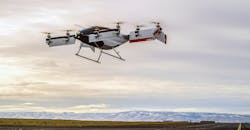Airbus reported that its all-electric, vertical-takeoff and landing (VTOL) passenger aircraft completed its first full-scale flight test recently, reaching a height of 16 ft. for a period of 53 seconds on January 31. A second, fully self-piloted flight was conducted the next day too, at the Pendleton UAS Range in Oregon.
The Vahana aircraft project is being developed by A3 (or “A-cubed”), a Silicon Valley project center backed by Airbus. Its objective is a self-piloted VTOL that will need no runways and can automatically detect and avoid obstacles and other aircraft. It is being designed to carry a single passenger or cargo.
According to the developers, the project will “democratize personal flight and answer the growing need for urban mobility by leveraging the latest technologies in electric propulsion, energy storage, and machine vision.”
Last year, A3 said its goal is stage the first certified passenger aircraft without a pilot.
“Today we are celebrating a great accomplishment in aerospace innovation,” Vahana project executive Zach Lovering said last week. “In just under two years, Vahana took a concept sketch on a napkin and built a full-scale, self-piloted aircraft that has successfully completed its first flight.”
About the Author
Robert Brooks
Content Director
Robert Brooks has been a business-to-business reporter, writer, editor, and columnist for more than 20 years, specializing in the primary metal and basic manufacturing industries.
